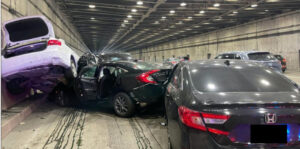The release of Tesla’s self-driving programming provides a promising peek into a technology fueled future. However, recent patterns of Tesla crashes leave many residents in the Bay Area — the country’s renowned tech capital and leading Tesla producer — wondering if it’s too soon to put their safety in the hands of technology.
California Tesla sales have increased exponentially over the past decade; the company held over 10% of the state’s new car sales in 2022, second only to Toyota. The Bay Area alone houses over 12,000 Tesla employees and contains a high concentration of Tesla owners and factories.
Tesla has proven to be an influential competitor in both the automobile and tech industries, producing the top two most popular electric vehicles in 2022: the Tesla Model Y and the Tesla Model 3. The company’s CEO, Elon Musk, is the second wealthiest person in the world, and plans to continue to grow his technological empire in the upcoming years.
In 2021, Musk released a groundbreaking fully self-driving hardware available to purchase for $15,000. As of April 2022, over 100,000 Teslas were registered possessing this software.
Basic Autopilot, a feature that has been included in all Tesla models since 2014, is available to perform simple steering and lane assistance, but requires the driver to supervise the software and remain in control of the vehicle.
Advanced Autopilot, introduced in 2016 for an additional $6,000 charge, provides more comprehensive and hands-off capabilities. The vehicle can assist the driver with parking, steering and maneuvering out of tight spaces.
Full Self-Driving Capability (FSD) as titled by Tesla was released in November 2022 and adds one more unique capability: traffic and stop sign control. This feature identifies traffic signals and stop signs at intersections in order to come to a complete stop and then accelerate. Tesla announced that they are working on an autosteer capability for city streets, as opposed to the previous auto-steer technology that is solely for highway use. This upcoming feature, along with any other future upgrades to the three technologies, are automatically synced and added to one’s car through updates to pre-existing software.
Although these three technologies can provide an almost completely self-driving automobile, Tesla still requires the driver’s supervision to maintain control of the vehicle and warns drivers that the vehicles are not autonomous.
The introduction of FSD spread a wave of excitement for what a technology driven future might look like, but these promising features quickly turned Tesla owners to fear as the company’s software has seemingly been responsible for countless car crashes in the Bay Area.
Tyler Hummel, a senior at Stuart Hall High School in San Francisco, recently got into a car crash due to a malfunction in Tesla’s assistance technology. Hummel reported that while driving on a city street in San Francisco, he was suddenly cut off by a car merging ahead of him. He was driving with an auto-assistance mode that is designed to minimize crashes, but in Hummel’s case, it did just the opposite. When the car detected the merging vehicle, it accelerated away to avoid the collision, however the car failed to detect a large pole ahead and ended up crashing the vehicle into the obstacle.
Hummel does not plan on purchasing another Tesla anytime soon and feels his experience breached his trust with the company. “I would not recommend for anyone to get a Tesla, nor to use the self-driving technology,” he said. “I don’t think it’s worth our time to be putting all this effort into self-driving cars because they can only function properly if all the cars on the road are also self-driving and on the same network.”
Multiple Bay Area Tesla-owners have experienced similar self-driving technological responsible collisions in the past few months.
On Thanksgiving Day, 2022, the driver of a vehicle in one such accident told California Highway Patrol that FSD “suddenly applied the brakes,” resulting in an eight-car collision on the Bay Bridge. Nine people were injured, including a two-year-old boy. The driver told authorities the vehicle attempted to make an unsafe lane change and came to a stop after this software malfunction.

photo courtesy of Forbes Magazine
Justine Jaremko ’24 shared a similar experience of her car suddenly disengaging from FSD. “Sometimes when I’m driving and the Tesla sees something and it doesn’t know what to do, it will just disengage,” she said. “I wouldn’t call the self-driving technology fully self-driving, because I always have to be ready to take the wheel if the software disengages.”
Although Jaremko noted the dangers of FSD, she also highlighted some of the promising aspects of the technology. “I think self-driving mode is definitely worth it, at least to try out, because it is useful in situations where you need to divert your focus for a second,” she said. Jaremko reflected that she often deploys the software when she needs to divert her attention and feels safer using FSD while distracted rather than in full control.
Jaremko’s father, Mark Jaremko, shared similar opinions on the software. “We have Autopilot, and I do find it helpful and reliable on long drives, especially on the highway, where the car can help in non-complicated scenarios,” he said.
Although Jaremko appreciates the software for minor assistance, he doesn’t fully trust the technology yet, and has noticed strange malfunctions in the software. “I’ve noticed that Tesla’s Autopilot mode can make odd choices in corner cases, accelerate into situations that a real driver would normally slow down, so it’s not surprising that some of these errors could happen at exactly the wrong time to cause a failure and a crash,” he said.
Tesla’s history of malfunctions has created concerns about the company’s reliability, yet Musk has continued to introduce new updates to the self-driving programming. At the meeting to discuss EV automakers’ third quarter financial results, Musk hinted at plans to produce fully autonomous vehicles before the end of 2023, but many doubt the accuracy of his estimate. Musk described his goal for these futuristic cars. “It will take you from your house to work to a friend’s house to the grocery store without touching the wheel … You’ll almost never have to touch the vehicle controls,” he told investors and Wall Street analysts attending the meeting.
Bay Area residents had varying responses to Musk’s timeline. Audrey Villiger, a junior at Head-Royce High School, thinks the new technology is intriguing, but very unnerving. “I think the technology is really cool, but I would like it to be tested more before release. I feel like the advancements are being introduced too quickly,” she said.
Even though Tesla production and sales have been on the rise, the software costs up to an additional $15,000 on top of the exorbitant selling price ($43,000 – $121,000). Musk claims these features will soon be available for all, but the stark expense to obtain this technology leaves many without such an opportunity.
As the country’s tech capital continues to debate the safety of self-driving technologies, many wonder what future technological advancements may lay ahead. Tesla wields a great deal of affluence and power, enabling them to provide astounding advancements to affording customers. The question that remains circulating with each release sparks varying answers within the Bay Area; is it time to put our safety in the hands of technology?







